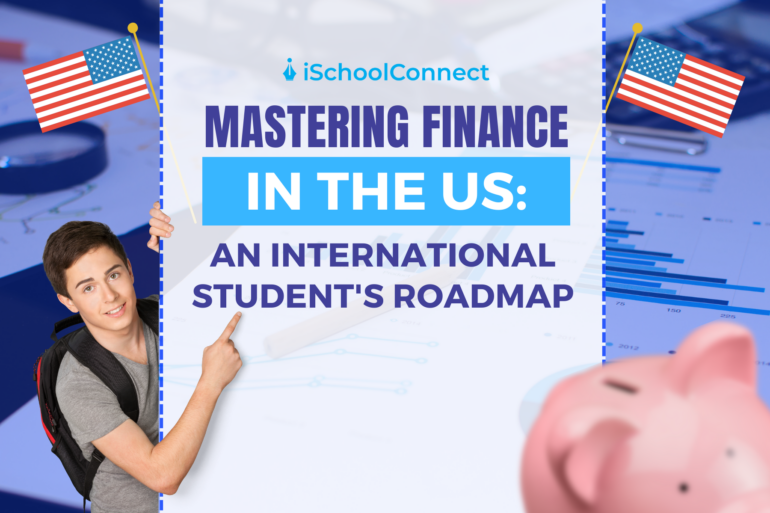Table of Contents
Application for Finance education in the US
Pursuing a master in finance in the United States can be a life-changing experience. It offers a world-class education and access to a vibrant job market. However, the application process for international students can be complex, and they might need some help with the submissions. This blog provides a step-by-step overview of the application process, from selecting the right program to preparing a compelling application.
Research and choose the right program
You should conduct extensive research and choose the program that suits your academic and professional objectives before applying to a course of master in finance. While considering courses, look for aspects such as-
- The programs should have accreditation from established bodies such as AACSB, CFA Institute, etc.
- Ensure that the course offerings, faculty expertise, and program structure align with your career goals.
- Remember that the location where you enroll to study is also important because it will affect your stay on campus and the possibility of doing an internship or networking.
- Ensure that you understand the program’s fee structure, scholarships available for it, and possible financial aid for international students.
Meet admission requirements
Most of the US universities have strict admission requirements for international students who wish to pursue a master in finance. Common prerequisites include-
- A bachelor’s degree in fields such as economics, finance, or business. However, most of these courses would allow students with non-business backgrounds but would recommend additional coursework.
- Submit your undergraduate transcripts, translated into English if required.
- Several of these programs also involve the GMAT and the GRE. Review the special conditions of your selected study course before applying.
- International applicants should have a command of the English language assessed through undertaking tests such as TOEFL or IELTS, among others. This means you must ensure that you meet the set minimum score standards for language proficiency.
- Seek recommendation letters, especially from professors or supervisors, who are able to confirm how qualified you are, as well as why you are fit for this program.
- Formulate an engaging statement of purpose that encompasses your educational and professional goals and reasons for pursuing the program.
Financial planning

Studying in the USA comes at a cost. Hence, you need to budget well for your expenses. Consider the following aspects-
- Find out how much the entire program will cost you, as well as any type of available financial help or scholarship programs.
- It is important to search for scholarships tailored for international students so as to ease financial stress. Secondly, try scholarships from your home country since some governments and organizations provide support money for pursuing your studies abroad.
- On-campus employment gives some international students an opportunity to raise money while they pursue their studies.
- Ensure that you understand the regulations and limitations governing off-campus employment since working without authorization would have serious ramifications on your visa status.
- Since most universities insist on health insurance and other related costs, a prospective learner will have to come up with a means to pay them.
Visa application
After accepting admission from your preferred program, you will then be required to obtain an American student visa. In the United States, the F-1 visa is the most frequently issued one for foreign students. Here are a few steps to apply for a study permit-
- Upon being admitted, your university will issue you a form I-20 that you must present during your application for the visa.
- SEVIS fee must be paid first before the scheduled appointment for a visa interview.
- Visit the United States embassy or consulate website of your home country and set up your F-1 visa appointment.
- Collect the necessary documents, such as your Form I-20, passport, visa application fee receipt, SEVIS fee receipt, passport-size photos, and any other documents requested by a specific consulate or embassy.
- Make sure you are ready to address matters regarding your education and finances during this meeting. Attend the interview with a proper dress code and all the required documents.
Prepare for arrival
Ensure smooth adjustment and transition while preparing for your arrival in the US as an international student. Consider these important steps before traveling-
- Make sure you have a place to stay (on-campus, off-campus, or temporary).
- When you arrive, attend the orientation for international students to find out about campus support services, such as campus facilities and academic resources. Meet other students at the university.
- Learn about American healthcare, your insurance policy, and ways to obtain medical attention while in the U.S.
- Make an expenditure plan to pay for your tuition fee, accommodation, travel, and books, among others.
- Find out more about American culture, do’s, don’ts, and local slang, as it would help you adapt.
Key takeaways
- Research an appropriate financial program that fits your educational and professional goals. It must have all the required accreditation and resources.
- Understand the requirements for admission, such as having an appropriate Bachelor’s degree or relevant degree, undertaking some standardized examinations, showing English language proficiency, applying through a recommendation letter, and a convincing statement of purpose.
- Do careful budgeting, bearing in mind tuition fees, available scholarship schemes, and on-campus employment and health insurance.
- Steps for obtaining an F-1 student visa include payment of the SEVIS fee, scheduling an interview, as well as submission of various important documents.
- Take a step to ensure secure accommodation, attend orientation as an international student, understand your health insurance, and acquaint yourself with American culture and traditions.
We hope this blog will help you in your journey to pursue education abroad. If you have any further questions or require more information, please don’t hesitate to reach out to us. Click here to contact us for personalized support and answers to all your questions.
Liked this blog? Read next: Finance Degree in Australia | Exploring Lucrative Career Options
FAQs
Q1. Are finance jobs in demand in the USA?
Ans- According to the U.S. Bureau of Labor Statistics (BLS), employment in business and finance will expand by 7% from 2021 to 2031, somewhat faster than the average anticipated growth for all finance jobs in the U.S. Certain financial roles, such as financial examiner, are expected to grow at a rate more than double the national average.
Q2. What is the course curriculum for the master in finance programs in the USA?
Ans- The master in finance course curriculum in the United States offers a wide range of topics, including financial management, financial accounting, investment theory and practice, risk management, and so on.
Q3. What is better, MBA Finance or MS Finance?
Ans- MS Finance is a more subject-oriented course that helps students gain expertise on a variety of related issues. MBA finance degree holders can hunt for careers in fields other than finance.






